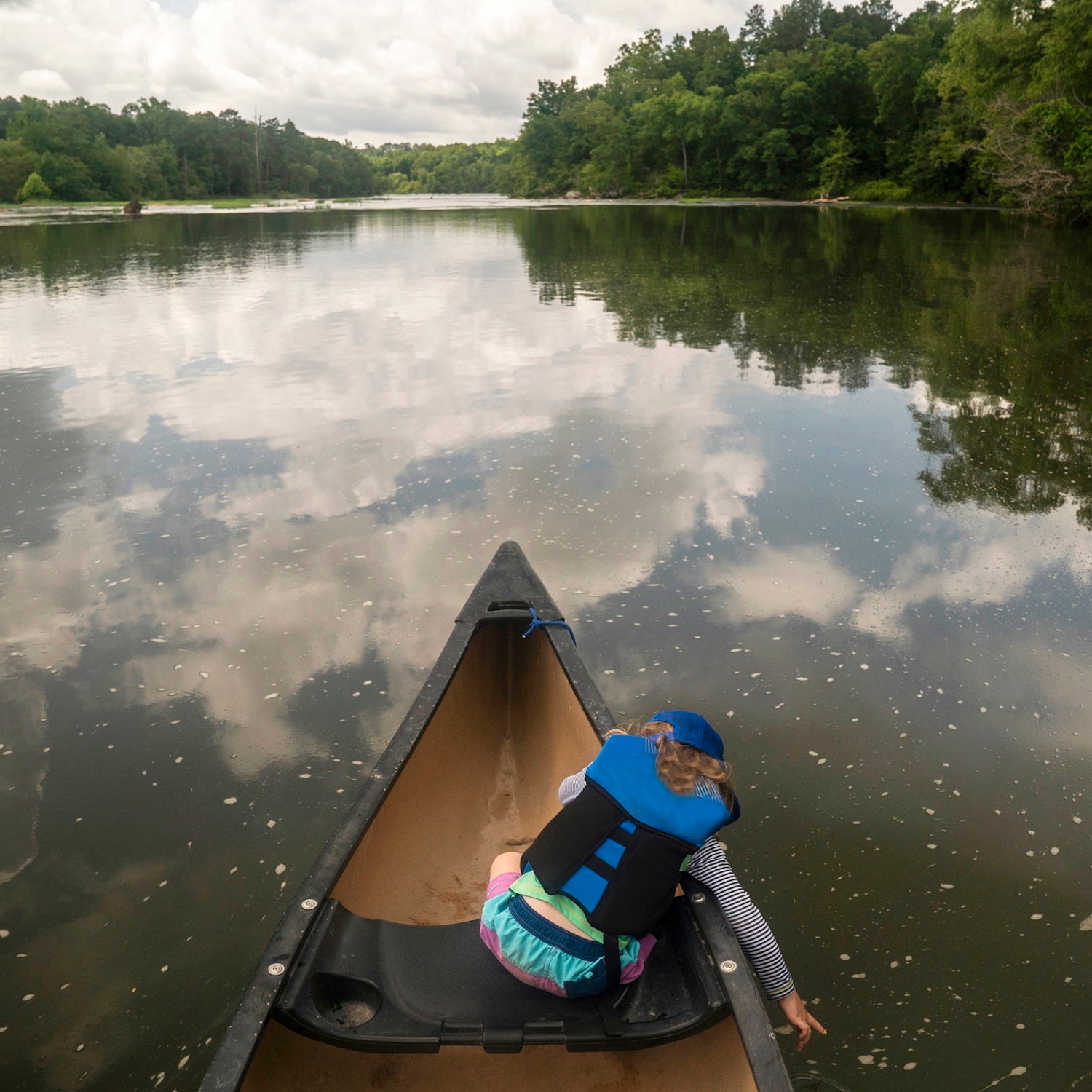I don’t usually stop to fish. On canoe trips, I’d much rather cover the miles while the wind is calm and save the fishing for after dinner. This trip, though, isn’t about the distance. When we pause in a deep, shady pool on the river, I can’t complain. Six-year-old Emily* has waited patiently since we left our campsite that morning for a chance to pull out her Spiderman fishing pole from the floor of the canoe. Emily sits between my husband, Bob, and me on a folding step stool.
Bob leans over to grab a hook and lure out of the tacklebox, his sun hat hiding his focused face as he upgrades Spiderman from a practice pole to the real deal. Emily beams as she throws in her line. Moments later, we hear her squeal and we watch with delight as she pulls a six-inch perch from the water. It’s her first catch ever.
We’re on a five-day paddle trip on the Moose River in Maine, just south of the Canadian border. After our launch, we won’t see anyone for four days, other than the three friends joining us. Plus a moose.
We fall into a familiar routine: rise at sunrise, cook breakfast over the fire, complain about putting on our wet shoes, pack up camp, and load the canoes. Our days are spent paddling, fishing, floating, and splashing in the water. Emily declares that the best part is swimming in her clothes.
Watching Emily flourish on this trip—her pride in completing a 1.25-mile portage carrying her own pack, her laughter when she and I tip the empty canoe at our campsite to go for a swim—is a relief. Emily is a child experiencing foster care, and she’s staying with Bob and me for several months while her family works towards reunification. We know that no amount of our love can ever erase the trauma of being made to leave, even temporarily, one’s original family. Even the most exciting outdoor adventures will never supplant the pain of being in foster care.
Over the past four years as foster parents, Bob and I have hosted four children individually and taken memorable adventures with all of them. As a P.E. teacher, I’ve seen the difference a stable home can make. I’ve also experienced the devastation of carrying three biological children in my womb, but never in my arms, so I knew what it was like to love a child fiercely and protectively. When a foster family moved to our neighborhood, we started to picture how we could help support kids and families in need.
In spring 2019, we went through the licensing process: applications, interviews, and home inspections. Then we took a ten-day adult-only canoe trip through the Labrador wilderness that summer, and waited for the phone to ring in the fall.
Foster parenting can be grueling—even more so for the kids. There are the usual ups and downs of parenting, plus countless meetings, appointments, and court hearings. We collaborate and coordinate with our kiddos’ families to ensure they stay connected, and get their blessing (and the case worker’s approval) before heading out on longer trips. We take classes on trauma-informed approaches to parenting and learn to help our foster kids work through the big feelings that come with being separated from their families.
We’ve found that spending time outside as a foster family benefits all of us. The child who craves our undivided attention gets it while sitting in between us in a 16-foot canoe. The child with boundless energy can burn it off with a bike ride. The child grappling with grief and anger can safely throw rocks in a stream.
We strive to meet our foster kids where they are, encouraging them to try something new but not demanding they do so. When one six-year-old requested to learn to snowboard in 2022, we embraced it, with Bob holding him and his board between his tele skis on the rope tow.
One summer, to set three-year-old Joseph* up for success in the backcountry, we found ourselves stacking multiple bulky plastic food containers in our portage pack so as not to squish his daily lunch of peanut-butter-and-jelly sandwiches. We’d tried, without success, to introduce more portable alternatives like wraps or hearty crackers in the weeks leading up to our traverse of the Whitney C. Wilderness area in the Adirondacks. A few days after our after the trip, having finally washed all of those plastic containers, Joseph started devouring peanut-butter-and-jelly wraps at our kitchen table. Sometimes the moment just has to be right.
Part of fostering for us has been celebrating with the children’s families when they’re reunified. Reunification happens when the state determines that the family is able to safely parent their child, having overcome the obstacles that led to their child being in foster care. For us, reunification is bittersweet as we’ve formed a strong connection during their stay with us. When possible, we stay in touch and continue to support the families—sending a package with school supplies in August or taking them on an outing over school break. We thrive when Bob and I can take a break just the two of us, pausing to process our return to life temporarily as a party of two.
Last summer, Bob and I ventured on a ten-day paddle in Quebec, where we would see no other humans and little evidence of previous visitors. With rapids to navigate and bush-whack portages, it was an adventure beyond what we could do with a kid in tow. It was physically and mentally strenuous and emotionally refilling—exactly the reset we both needed. We welcome the reprieve of time spent outdoors as a constant in our ever-changing family.
*Names and identifying details have been changed to protect confidentiality.


